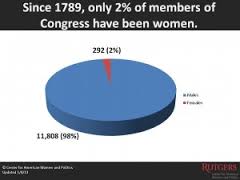 PEW just posted a quick look at the 115th Congress that began in 2017. See Report: Click Here They looked at 5 demographic factors.
PEW just posted a quick look at the 115th Congress that began in 2017. See Report: Click Here They looked at 5 demographic factors.
- How ethnically diverse? PEW reports: “The current Congress is the most racially and ethnically diverse ever. Nonwhites – including blacks, Hispanics, Asians/Pacific Islanders and Native Americans – now account for 19% of Congress.” How does it compare to the past? In 1945, just 1% were non-whites. So better than the past. Yes. But how does it compare to the nation as a whole? 38% of the nation is nonwhite. So, there is still progress to be made here. Note: the chart they use is not helpful. It shows the breakdown by ethnicity but does not include whites, so the reader has not sense of the percentages of the whole.
- How are women doing? It is slow. “Women now hold 104 seats, or about one-in-five overall (19%), tying the record set by the 114th Congress.” Their chart shows the percent of women in the senate and the house separately, over time, but do not show the overall percent over time. . However, they do acknowledge that women comprise 51% of the population, so they are still under-represented. Center for American Women and Politics puts it in a bigger picture:
 For More info From CAWP Click Here
For More info From CAWP Click Here
- Military experience?
PEW chose to look at military experience as a factor. They write: “Between 1965 and 1975, at least 70% of each legislative chamber had military experience. The share of members with military experience peaked at 75% in 1967 for the House and at 81% in 1975 for the Senate.” In contrast, 20% of senators and 19% of representatives in the current Congress have served in the military at some point in their careers. Looking at the country as a whole, PEW writes: “In 2014, just 8% of U.S. adults had military experience; in 1980, 18% did.”
- Educational level?
“Nearly all members of Congress now have college degrees. In the 115th Congress, 95% of House members and 100% of senators have received a four-year degree or higher.
In the 79th Congress (1945-1947), by comparison, 56% of House members and 75% of senators had degrees.
In 2015, just 33% of American adults ages 25 and older said they had completed a bachelor’s degree or more.
- Religious Identity. Congress has tended to be about 90 percent Christian over time, and is so in 2017. The difference, according to PEW, is the changes in Catholics and Protestants: “Catholics now make up 31% of Congress, up from 19% in 1961. Protestants, on the other hand, have fallen from 75% in 1961 to 56% today.” The distribution is a bit different from the population as a whole. PEW notes, “far more Americans identify as “unaffiliated” than do Congress members (23% v. 0.2%). In 2014, 48% of Americans identified as Protestant, while 21% identified as Catholic.”